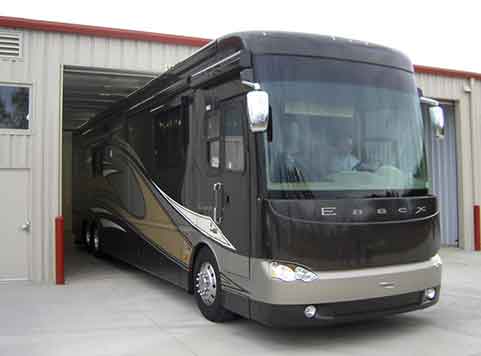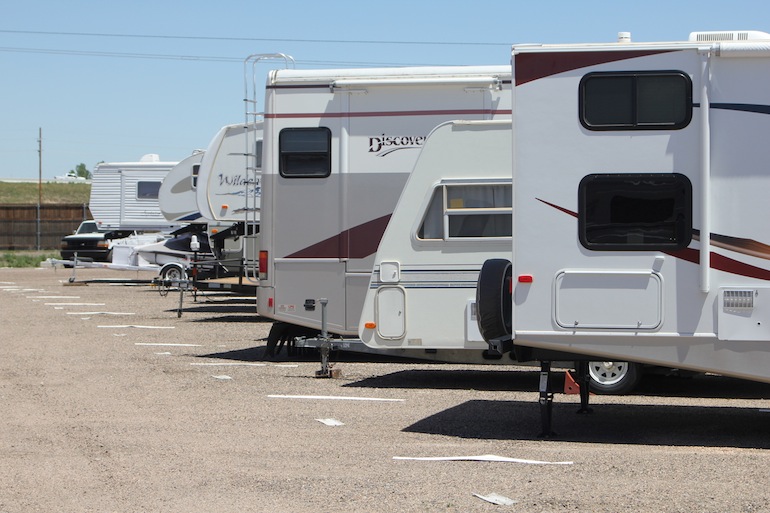Sites that facilitate peer-to-peer RV rentals saw a huge boost in traffic and transactions during the most intense phase of the coronavirus pandemic. That’s because traveling to parks by motorhome was one of the few relatively safe activities that could be enjoyed. As such, it was one of the few industries that really prospered during the pandemic.
Many RV dealers across the nation reported increased traffic and strong sales during the pandemic. While RV sales have declined since their pandemic highs, the surge created lots of new RV owners. Many are now faced with a problem they might not expect—finding a place to park their RV when not in use.
Some might be surprised that their HOA prohibits RV parking on their own property. City dwellers might find street parking difficult or illegal. That means prospective buyers should consider RV storage fees as part of the overall cost of ownership.
How Much Does RV Storage Cost?
Good news for RV owners: the cost to store some RVs has gone down since last year when they reached record highs. That means now might be a good time to shop around for a good deal on RV storage.
The cost to store an RV in 2023 is between $119.88 and $169.35 a month. Those are the year-to-date average for 40’x10′ and 30’x10′ storage units, respectively, reserved on SpareFoot.com. Those are the most common sizes large enough to accommodate RVs and campers.
2023 RV Storage Prices Monthly (YTD)
30×10:
- $0.56 per sq.ft.
- $169.35 per month
- -17.6% down from same period last year
40×10:
- $0.30 per sq.ft.
- $119.88
- +10.6% up from same period last year
2022 RV Storage Prices Monthly
30×10:
- $0.69 per square foot
- $205.08
40×10:
- $0.33 per square foot
- $132.58
As you can see, the cost to rent a 30×10 unit has gone down by 17%, while the cost of larger 40×10 units has increased. The discrepancy is likely due to a shortage of larger units relative to the number of new owners of large RVs. The construction of RV storage is one of the fastest growing segments within the self-storage industry for this very reason. As more are built, this could eventually lead to lower storage prices for RV owners who need 40 foot spaces. But in the meantime Class B owners are looking like the real bargain winners.
Why Do Storage Prices Vary So Much?
RV storage prices vary widely depending on the size of the market, the local supply of storage spaces, the quality of the facility, and whether the storage area is fully enclosed or out in the open air.
For example, you’ll pay much more to store an RV in an enclosed space that is located near an urban center or resort area than you would pay for an outdoor parking space in a small town or rural county.
To give you an idea of how much RV storage costs in different locales, here are the average monthly rents for a 10’x40′ storage unit in the top largest U.S. metro areas year-to-date in 2023:
- Atlanta, GA: $204.90
- Chicago, IL: $140.37
- Dallas, TX: $119.25
- Denver, CO: $180.87
- Houston, TX: $95.14
- Los Angeles, CA: $274.92
- New York, NY: $264.01
- Phoenix, AZ: $188.70
- San Francisco, CA: $266.54
- Washington D.C.: $163.01
What Types of RV Storage Options Are There?
RV owners often use self-storage facilities because of limited space on their own properties, or because of regulations against large-vehicle storage imposed by cities and homeowners associations. Secure RV storage also helps owners avoid incidents of vandalism.
Sam Whitaker, former president of the Fleetwood Motorhome Association in Athens, AL, said he uses self-storage because his homeowners group limits the amount of time RVs can be parked in his neighborhood.
“It is in the covenants,” he said. “We can park to load, and that is it.”
Whitaker said he considered storing his RV in a fully enclosed space for $300 a month, but frugality led him to choose a covered outdoor space for $70 a month.
When choosing an RV storage facility, keep in mind the various types of storage spaces available, in order from most affordable to most expensive:
- Outdoor, uncovered RV storage. This is the most affordable option, but also provides the least amount of protection for your RV. This is essentially a space in an outdoor parking lot for your vehicle.
- Outdoor, covered RV storage. This RV storage type is an outdoor parking spot that is protected by an awning structure. This reduces the damaging effects of sun and rain.
- Shared indoor RV storage. This type is a large indoor garage that can hold multiple recreational vehicles, vans, boats, trailers and campers. You would be sharing the space with other tenants, but would have your own reserved spot.
- Private indoor storage. This type of storage provides the most protection for your RV, but it is also the most expensive option. Opting for a climate-controlled RV storage unit would make it even more expensive. This is essentially a larger version of a self-storage unit that is typically used to keep household goods.
Some facilities have made RV storage their specialty, offering such amenities as “dump stations” that let tenants drain wastewater from their storage tanks. Also, some enclosed climate-controlled units that come with sinks to help with cleanup.
Most RVs and many travel trailers might not fit in a standard storage unit due to the ceiling height. Always check with the storage operator to see if their large units are suited for RV parking.
Remember:
- A minimum length of 25′ to 35′ is recommended for most Class B vehicles.
- A minimum length of 30′ to 35′ is recommended for most Class C campers
- A minimum length of 35′ to 40′ is recommended for Class A motorhomes
Choosing an RV Storage Facility
If you decide to store your RV at a self-storage facility, your top priority should be good security, said David Blunt, a member of the Circle City Campers RV club in Corona, CA. Thieves sometimes target RVs because they often contain expensive electronic equipment, he said.
It would be safer to remove all valuables before storage, but many RV owners find loading and unloading vehicles to be inconvenient, Blunt said. That’s why good security is essential.
“With RVs, you leave a lot of stuff, your TV, your stereo,” he said. “Who is watching the [storage] place?”
When you visit facilities, look for security cameras, fencing, and gates that require the use of personal security codes. Blunt says personnel should be on duty around the clock to keep an eye on parked vehicles.
The safest place to store an RV is in a locked, enclosed unit, but not all self-storage facilities have units that are large enough. Any RV that is parked outdoors should be covered to protect it from the elements. For added protection, try to find a facility with carport-style parking when indoor parking is not available.
No matter what type of space you rent, be sure to take measurements to make sure it’s large enough to hold your vehicle and allow you to enter and exit comfortably. Next to security, the most important thing is easy access to your road chariot.
How Do You Prepare an RV For Storage?
When keeping your vehicle in storage be sure to do the following:
- Remove all valuables
- Drain water tanks and clear lines
- Fill up the fuel tank
- Thoroughly clean the vehicle inside and out
- Prop open the refrigerator door to prevent mold
Once you’ve chosen a facility, you’ll need to prepare your RV for storage. Whitaker said it’s important to drain all water from your storage tanks and water lines. If you’re worried about pipes freezing during winter months, he suggests adding a nontoxic RV antifreeze to the kitchen and bathroom plumbing.
Be sure to fill up your fuel before storage to prevent condensation. You can add a stabilizer to prevent your fuel from breaking down. If you plan to park for more than a few months, it’s best to drain the tank and refill it when you’re ready to return to the road. Top off your propane tanks or remove them empty. Don’t leave them connected to your rig half full.
Thoroughly clean your RV before storing it and make sure any fabric awnings are dry. Don’t forget to close your window blinds to avoid sun exposure to upholstery, carpets and draperies.
When parking outdoors, if you place wood or plastic beneath your tires to make sure they’re not touching the ground, it’ll help prevent the rubber from aging and cracking during storage, Whitaker said. Inside your RV, remove all perishable foods.
People who are new to RVing often forget to prop open refrigerator doors to prevent mold from growing, Blunt said. “That is the number one mistake that newbies make,” he said.
Monica Rivera, manager of the El Monte Store It Now storage facility in El Monte, CA, said facilities typically have strict requirements for the RVs they accept.
First and foremost, the RV’s engine must be in working order. Be prepared to demonstrate that your RV is properly registered, licensed and insured. The goal of such rules is to prevent facilities from becoming dumping grounds for old vehicles.
RV Storage FAQ
How much does it cost to store an RV?
The average price of an RV storage space on SpareFoot was about $130 a month. Prices vary widely depending on the type of storage and location within the United States.
What types of RV storage are there?
RVs are stored outdoors, outdoors with an awning, in shared enclosed spaces, or in private enclosed units.




